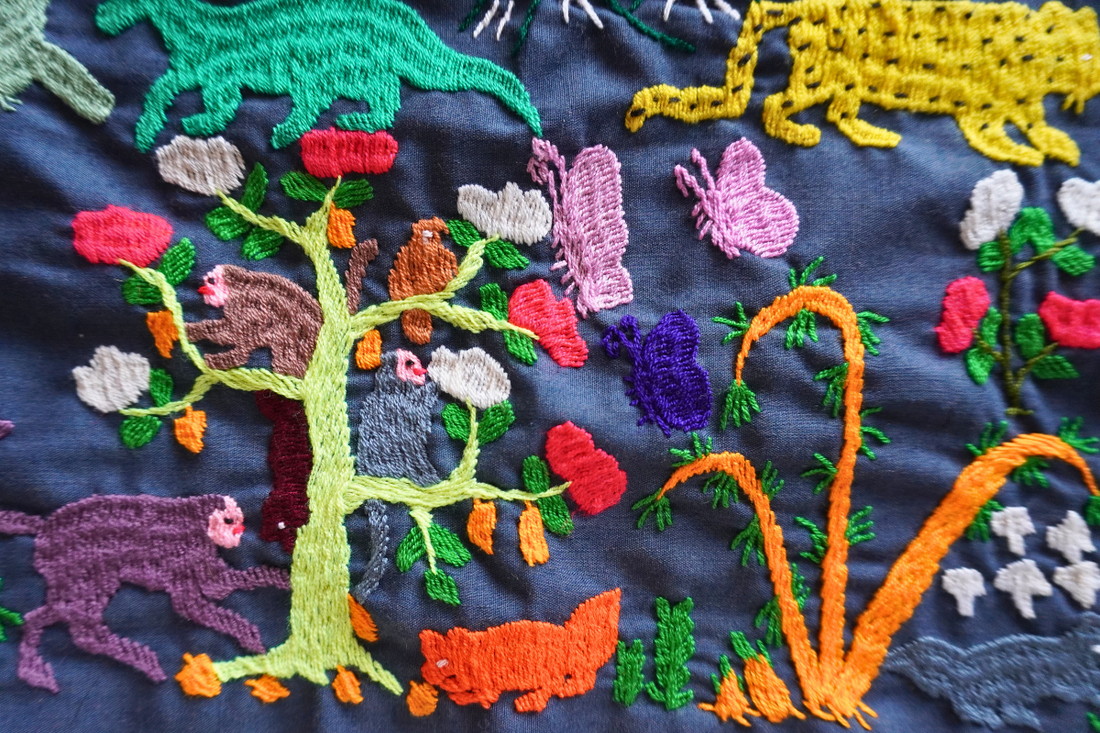
When words are silenced, cloth speaks.
Share
Throughout history, fabric has been more than just decoration or clothing, it has served as a medium for communication, silent testimony, and visual resistance.
It all began with a few pieces of embroidered fabric I picked up at a night market in Laos, colorful, intricate, handmade. At the time, they were just souvenirs. I didn’t know who had made them or what they represented. But back home, a chance encounter with a book in the library revealed a deeper truth: those threads held more than just patterns. They held stories of war, memory, resilience, and identity.
Across the world, embroidery has long served as a language of its own. For communities without a written script and for women whose voices were often silenced, needle and thread became tools of expression. What appears decorative is often deeply personal, political, or historical. When words are lost or forbidden, fabric finds a way to speak.
 Hmong embroidery story cloth. Unknown artist, 1980s-1990s
Hmong embroidery story cloth. Unknown artist, 1980s-1990s
The Voice of the Shuttle: From Myth to Message
The idea that textiles can “speak” is ancient. In Greek mythology, Sophocles wrote of Philomela, who, after being raped and silenced by having her tongue cut out, wove her story into a tapestry. Through her embroidery, the truth emerged, leading to justice.
In Homer’s Iliad, Helen of Troy weaves scenes of the war caused by her abduction. In European fairy tales, embroidery often carries meaning too, like the girl who must remain silent for six years while weaving shirts from nettles to save her cursed brothers. Her textile labor becomes both her voice and her salvation.
A Thread of Feminine Resistance
In more recent history, women have continued to use embroidery as a form of resistance. The Chilean arpilleras bright, patchwork textiles made during the Pinochet dictatorship at first appear cheerful, but closer inspection reveals scenes of oppression, disappearance, and grief. Some even incorporate fabric from the clothing of the “disappeared,” silently asking: Where are they?
In Bihar, India, women have stitched painful personal experiences, such as domestic violence and female infanticide, onto old saris. These works have since been exhibited globally, transforming private trauma into collective testimony.

Arpillera, Unidentified artist, Chile c1980 - Collection of John Beck and Ann Austin
Memory Stitched Into Cloth
The AIDS Memorial Quilt, started in 1987, is one of the most powerful textile memorials in modern times. Each panel commemorates a life lost to HIV/AIDS, humanizing a crisis that was once deeply stigmatized. In South Africa, during and after apartheid, women created “memory cloths” to document their lives, often shared through spoken word performances alongside the textiles.
 Journey to Freedom, Memory Quilt, Intuthuko Sewing Group, South Africa 2004
Journey to Freedom, Memory Quilt, Intuthuko Sewing Group, South Africa 2004
Collection of UNISA (University of South Africa)
Stitching Across Languages
Among the Hmong people,refugees from the Vietnam War, embroidery became a way to document displacement and survival. In refugee camps and later across the diaspora, women stitched story cloths depicting bombings, border crossings, and rural village life. These embroidered narratives preserved history and also helped women earn an income by selling their work.
 Tapestry portrays the Secret War in Laos, during the Vietnam War Era. Unknown artist, 1980s-1990s
Tapestry portrays the Secret War in Laos, during the Vietnam War Era. Unknown artist, 1980s-1990s
An Unexpected Encounter with Meaningful Threads
Back in Laos, I had stumbled across a market filled with handmade crafts. Local women had set up stalls offering paintings, small trinkets, and vividly embroidered textiles. I didn’t know their significance, but I was drawn to them, their textures, colors, the care woven into each piece. I bought a few, thinking maybe I’d use them creatively one day.
It wasn’t until I returned home and found that book that I understood their deeper meaning. What I had bought were not just pretty souvenirs. These pieces no longer depicted war, but they were made by the same hands of women who once embroidered memories of trauma and now depict animals, village life, and scenes of tradition. Their work remains a way of preserving culture and making a living. As tourists, we often take home what we assume are simple keepsakes when in fact, we carry fragments of lived histories stitched in silence.
When words are silenced or forgotten, the needle still finds a way.
And sometimes, it speaks louder than anything else.
